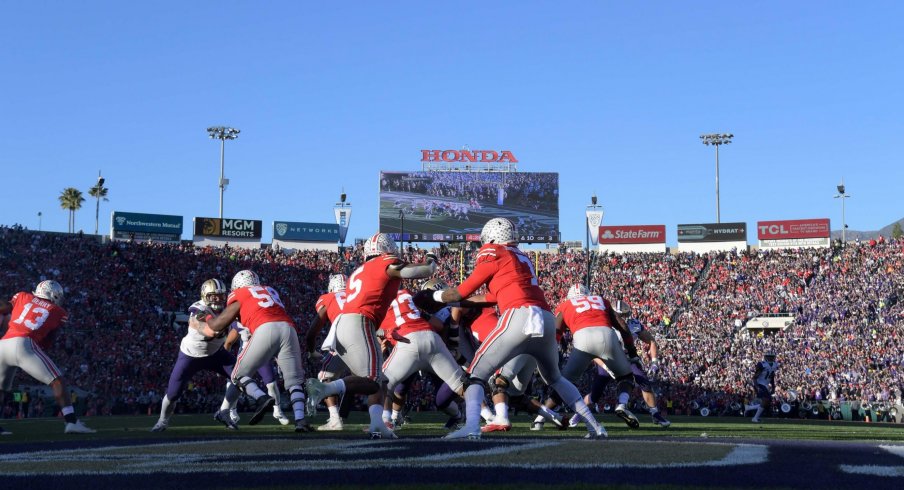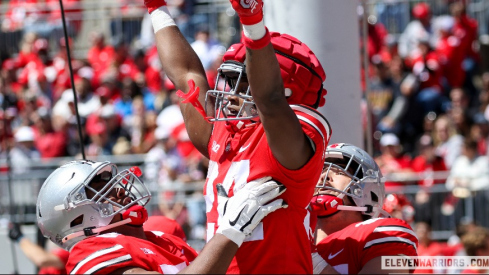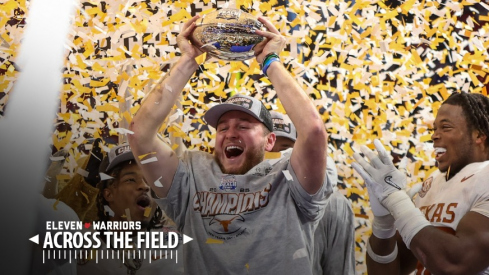“I think we jumped out fast, but that was a heck of a team we played tonight.” - Urban Meyer
Last week's Rose Bowl victory was in many ways a microcosm of Ohio State's 2018 season as a whole. While events off the field dominated headlines, a handful of crucial injuries led to an inconsistent running game and placed even more weight on the shoulders of Dwayne Haskins and his veteran corps of receivers.
Facing a top-15 defense for the third time in their last five games, the Buckeyes' record-setting offense was held to less than 400 yards for only the third time all year. Washington's heavy reliance on classic 'spot-drop' zone defenses slowed the nation's #2 unit in total yards, though not initially.
After an initial three-and-out on their first possession, the Buckeyes marched down the field on their second thanks to a physical running game that was responsible for 62 of 77 yards on the drive. With the Huskies' interior linemen playing a '2-gap' technique in which the massive defenders try to occupy blockers in hopes of freeing All-American Ben Burr-Kirven to make tackles, OSU was able to neutralize the star middle linebacker by pulling the backside guard in the Power-O concept and leading the way for Mike Weber to find running lanes.
Facing a critical 4th & 1 scenario later on the same drive, the Buckeyes lined up in an unusual formation (for them, at least) with two tight ends to the boundary and two receivers wide to the field. As Chris Olave streaked across the formation and appeared to take a Jet Sweep around the edge, the Husky corner responsible for setting the edge got caught too far outside and was unable to corral Weber as he bounced the run, catching the Huskies out-leveraged in the opposite direction.
"Coach Mick and Meyer preach about the winning line of scrimmage," Haskins said following the Rose Bowl game. "So today Mike [Weber] ran the ball really efficiently and got a lot of first downs with him. Opened up the passing game for us, giving us some wide-open lanes and as far as impacting the zone coverage."
Weber wasn't the only player not to start in week one who made an impact on the running game. After Demetrius Knox suffered a season-ending foot injury in the final minutes of his team's huge win over Michigan, redshirt sophomore Wyatt Davis stepped in to start at right guard in both of Ohio State's postseason contests.
As many would expect, Davis' first career start in the Big Ten championship game saw him struggle at times. In his second, however, he showed why he was the nation's top-ranked guard in the recruiting class of 2017. Lined up directly between a pair of three-year starters in center Michael Jordan and right tackle Isaiah Prince, Davis looked the part as well.
After the two-gap look began to give up some big runs, the Huskies began mixing in odd, three man fronts with a nose guard directly over the center and ends lined up in the 'B' gaps between the guards and tackles. This new alignment may have stymied the Power-O concept, but opened up the Buckeyes' base Tight Zone run with Davis anchoring the backside 'A' gap with combo blocks on the nose before getting up to the second level.
This early success on the ground laid the foundation for a big first half, with 109 yards coming on the ground at an average of over five yards-per-carry.
"I think in every game, you know, a big thing we want to do is establish the run early," receiver Parris Campbell told the media following the game. "Just from speaking from a receiver standpoint, having defenses worry about the run early on definitely makes it easier on us because defenders play a little soft, they might want to load the box, and it makes it easier on us."
From Campbell's point of view, it certainly must've felt like a great start, as the Huskies began keying on the OSU run game early and often, leaving he and other downfield threats open. Despite lining up against one of the best secondaries in the country (even without injured All-American safety Taylor Rapp), Haskins, Campbell, and company completed 15 of 24 pass attempts for 163 yards in the first half.
As they continued to mix their fronts, the Huskies also employed classic, spot-drop zone coverages that allowed the back seven to keep eyes in the backfield at all times. While conservative, in theory, these coverages allowed Haskins and crew to attack any hesitation downfield.
By the start of the second quarter, Haskins was clearly in a groove and the Huskies were on their heels. Afraid of giving up the deep ball, the UW defense leaned almost exclusively on Cover-3 zones, allowing a safety to line up in the box as an extra linebacker with plenty of coverage still downfield.
The result was a number of open windows underneath, in which Ryan Day attacked relentlessly with counters to his best-known concepts. Instead of running the full Mesh concept as they had with great success against the Michigan defense, Day instead asked his crossing receivers to sit down and run pivot routes back outside to find seams in the zone defense.
Not all the success came from play-calling, either. Haskins made a number of throws throughout the evening in which he reminded everyone why he's considered the top pro QB prospect in the country, and the best candidate in years to break the Big Ten's draft drought (Kerry Collins was the last B1G QB selected in the first round, in 1995).
In the example below, Haskins immediately recognized the Huskies' Cover-3 look after the snap, knowing where Bin Victor's post route would break open. However, with seven sets of eyes set squarely on him, he had to drop the ball in with a perfect arc over the first level zone defenders.
With Haskins cooking and the run game continuing to fire, Washington defensive coordinator Jimmy Lake began to take some risks, sending pressure to disrupt the Buckeyes' explosive offense. Initially, this approach backfired, with Haskins identifying the man-coverage behind the blitz and dropping yet another perfect ball over the shoulder of a streaking K.J. Hill downfield.
As the second half kicked off, however, the tide began to shift.
While Davis held his own on the right side of the Line, Lake and the Huskies recognized there was another new starter on the Buckeye offensive line, left tackle Josh Alabi. Subbing in for the injured Thayer Munford, Alabi was far less heralded than Davis coming out of high school, with many expecting the Detroit native to play defense in college.
After a quiet first half, Alabi faced a barrage of pressures meant to confuse him in the second, leading to a number of short dump-offs and incompletions that stalled countless Buckeye drives.
Many fans lamented the fact that Ohio State was throwing the ball at all, though, sitting on such a big second-half lead. In reality, Lake found a way to slow down that aspect of the offense as well.
By shifting the alignment of his front four linemen just before the snap, in a technique known as stemming, the Huskies disrupted the communication between the Buckeye O-linemen already in-place and forced them to identify new assignments on the fly.
While the shifting front gave the Buckeye blockers plenty of trouble, the biggest reason Ohio State couldn't run the ball in the second half was Burr-Kirven. As seen above, the nation's leading tackler showed how he was able to rack up 176 total stops this season, adding 11 to that total in his final game as a Husky.
Burr-Kirven rarely gave blockers like Prince (above) the chance to square up on him, knifing through their blocks before wrapping up a ball-carrier. He was also heavily utilized as a blitzer in the second-half, forcing Haskins into a pair of incompletions and a sack.
In total, these adjustments held the Buckeyes to a dismal 92 total yards in the second half and only four of which came on the ground. Luckily, though, by then the Buckeyes had built up enough of a lead to withstand Washington's final push in the fourth quarter.
"That's a top 10 defense, one of the best defenses we faced in the last few years," Urban Meyer said after being handed the Rose Bowl trophy for the first time in his career. "And they were playing zone coverage, and we had to be patient because they went around us, over the top, and I thought Dwayne did a great job.
"And the offensive line blocked a very good D line. We ran the ball. Very good balance. Didn't turn the ball over. Had nice drives. But obviously the fourth quarter, it's up 28-3, and we gave up three scores, and we don't score at all.
"So I think we jumped out fast, but that was a heck of a team we played tonight."



